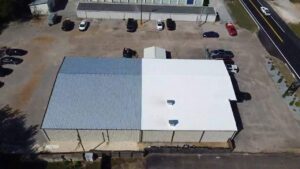
Steep slope roofing is a critical aspect of any commercial building in Memphis. The unique characteristics of steep slope roofs, along with the materials used and the installation process, play a significant role in ensuring the durability and effectiveness of the roofing system. In this article, we will explore the key aspects of Memphis commercial steep slope roofing, including its importance, installation process, maintenance, and repair. Additionally, we will guide you on how to choose the right contractor for your steep slope roofing needs.
Understanding Steep Slope Roofing
Steep slope roofing refers to roofs with a pitch greater than 3:12. They are characterized by their steep angles, which allow for efficient drainage and resistance against weather elements. These roofs often feature shingles, tiles, or metal sheets, providing a more visually appealing aesthetic to the building.
Key Characteristics of Steep Slope Roofs
Steep slope roofs have several key characteristics that differentiate them from other roofing systems:
- Enhanced water runoff: The steep angles ensure quick water drainage, preventing water from pooling on the roof and causing potential damage.
- Improved attic ventilation: The increased slope creates more space for effective airflow within the attic, reducing moisture buildup and enhancing energy efficiency.
- Greater wind resistance: The steep slope helps to minimize the impact of strong winds on the roof, making it more secure and durable against severe weather conditions.
Imagine standing on a hilltop, gazing at a picturesque landscape. The slope of the land adds a touch of elegance and drama to the scenery. Similarly, steep slope roofs bring a sense of grandeur and architectural beauty to buildings. With their sharp angles and bold presence, they create a striking visual impact that can elevate the overall design of a structure.
But it’s not just about aesthetics. Steep slope roofs offer practical advantages as well. The steepness of these roofs allows rainwater to swiftly cascade down, preventing any pooling or accumulation that could lead to leaks or structural damage. This efficient drainage system ensures that the roof remains dry and protected, even during heavy downpours.
Materials Used in Steep Slope Roofing
A variety of materials can be used for steep slope roofs, each offering unique benefits:
- Asphalt shingles: These are the most common and cost-effective option. They come in various colors and styles, providing versatility in design.
- Metal roofing: Metal sheets offer durability and longevity, along with excellent resistance against fire, wind, and impact.
- Tile roofing: Popular for their aesthetic appeal, tile roofs are known for their durability and ability to withstand extreme weather conditions.
When it comes to steep slope roofing, the choice of materials plays a crucial role in determining the overall performance and longevity of the roof. Asphalt shingles, with their affordability and wide range of options, are a popular choice for homeowners and contractors alike. They provide reliable protection and can be customized to match any architectural style.
For those seeking a more robust and long-lasting solution, metal roofing is an excellent option. With its exceptional durability and resistance to fire, wind, and impact, metal roofs offer unparalleled protection against the elements. They are also environmentally friendly, as they can be made from recycled materials and are highly energy-efficient.
Tile roofing, on the other hand, brings a touch of elegance and timeless beauty to steep slope roofs. With their rich colors and intricate designs, tile roofs have been favored by homeowners for centuries. Not only are they aesthetically pleasing, but they also provide exceptional durability and can withstand even the harshest weather conditions, making them a popular choice in regions prone to hurricanes and heavy storms.
Importance of Steep Slope Roofing in Memphis
Considering the specific weather conditions and architectural considerations in Memphis, steep slope roofing holds a vital role in protecting commercial buildings from potential damage.
Weather Conditions and Roofing Choices
Memphis experiences a mix of weather conditions, including humidity, heavy rain, and occasional strong winds. Steep slope roofing can effectively combat these elements, ensuring the longevity of the roof and the safety of the entire building structure.
Architectural Considerations in Memphis
The architectural style of buildings in Memphis often calls for steep slope roofs. Whether it’s a historical structure or a contemporary design, steep slope roofing complements the overall aesthetics and adds value to the property.
Installation Process of Steep Slope Roofs
The installation process of steep slope roofs requires careful planning and execution to ensure a successful and durable roofing system.
Pre-Installation Preparations
Prior to installing the steep slope roof, several essential steps need to be taken:
- Roof inspection: A thorough inspection of the existing roof is necessary to identify any underlying issues and determine if repairs or replacements are needed.
- Material selection: Choosing the appropriate roofing material based on the building’s architectural style, weather conditions, and budget is crucial for a successful installation.
- Permit acquisition: Ensuring compliance with local building codes and obtaining necessary permits is essential to prevent any legal or safety issues during construction.
Steps in Installing Steep Slope Roofs
The installation process typically involves the following steps:
- Roof deck preparation: The existing roof deck is inspected, repaired if necessary, and prepared to provide a stable foundation for the new roofing system.
- Underlayment installation: A waterproof underlayment is applied to the roof deck, serving as an additional layer of protection against water infiltration.
- Roof covering installation: The selected roofing material, such as shingles, metal sheets, or tiles, is installed meticulously, ensuring proper alignment and secure fastening.
- Flashing and ventilation installation: Flashing is installed around roof penetrations and vulnerable areas to prevent water intrusion, while adequate ventilation systems are implemented to enhance airflow and reduce moisture buildup.
Maintenance and Repair of Steep Slope Roofs
Regular maintenance and prompt repair of steep slope roofs are essential to extend their lifespan and ensure optimal performance.
Regular Maintenance Tasks
Some crucial maintenance tasks include:
- Gutter cleaning: Clearing debris from gutters and downspouts prevents clogs and ensures proper water drainage.
- Inspection of shingles or tiles: Regularly inspecting the condition of shingles or tiles allows for the early detection of any damage or signs of deterioration.
- Trimming trees: Trimming overhanging tree branches helps to prevent potential damage from falling limbs and allows for better sunlight exposure and airflow on the roof.
Identifying and Repairing Roof Damage
In the event of roof damage, it is crucial to take immediate action to avoid further issues:
- Professional inspection: Engage a reputable roofing contractor to thoroughly inspect the roof and identify the extent of the damage.
- Prompt repairs: Based on the inspection findings, necessary repairs should be carried out swiftly to prevent water infiltration and structural damage.
Choosing a Commercial Steep Slope Roofing Contractor
Selecting the right contractor for your steep slope roofing project is essential to ensure high-quality workmanship and a successful outcome.
Qualities to Look for in a Contractor
Consider the following qualities when evaluating potential contractors:
- Experience and expertise: Look for contractors with extensive experience in installing and maintaining commercial steep slope roofs.
- Licensed and insured: Ensure that the contractor holds the necessary licenses and has adequate insurance coverage to protect both parties involved.
- Reputation: Research customer reviews and ask for references to gauge the contractor’s reputation and reliability.
Questions to Ask Your Potential Contractor
Before making a final decision, ask your potential contractor the following questions:
- What certifications or specialized training do your employees hold?
- Do you offer any warranty or guarantee for your work?
- Can you provide a detailed estimate and timeline for the project?
By considering these factors and asking the right questions, you can make an informed decision when selecting a commercial steep slope roofing contractor for your Memphis building.
In conclusion, Memphis commercial steep slope roofing plays a crucial role in protecting buildings from weather elements and enhancing their overall aesthetics. Understanding the key characteristics, materials used, installation process, maintenance, and repair aspects are essential for maintaining a durable and effective roofing system. By carefully selecting a reputable contractor and conducting regular maintenance, you can ensure the longevity and performance of your commercial steep slope roof.
Don’t let the unpredictable Mid-South weather compromise the integrity of your commercial building’s steep slope roof. Trust the expertise of Commercial Roofing Rana, where we’ve been safeguarding properties like yours since 1983. Our Duro-Last roofing systems are precision-engineered for the perfect fit, offering unmatched protection for industrial facilities, commercial stores, municipal buildings, and more. With a legacy of quality service in Memphis and across the Mid-South, our licensed professionals are dedicated to delivering exceptional results that stand the test of time. Whether you manage a healthcare center, church, government building, or shopping center, Schedule Now with Commercial Roofing Rana to ensure your property is equipped with a top-tier roofing system that’s ready for anything.
